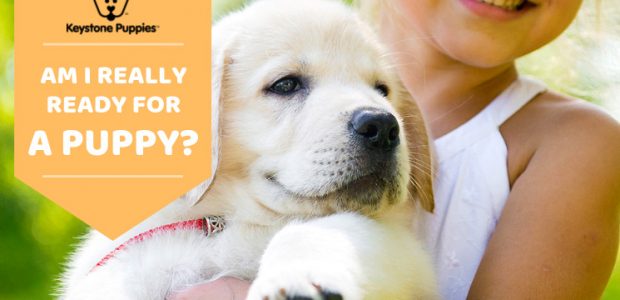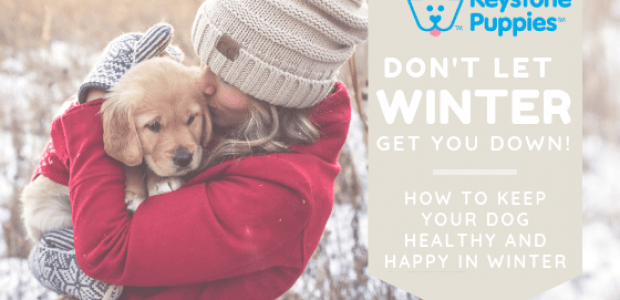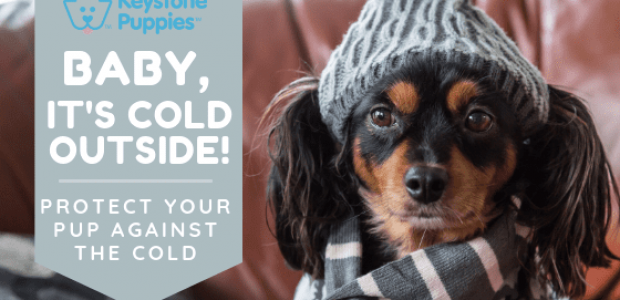Muddy Paws: Tips for Paw Care After Walks
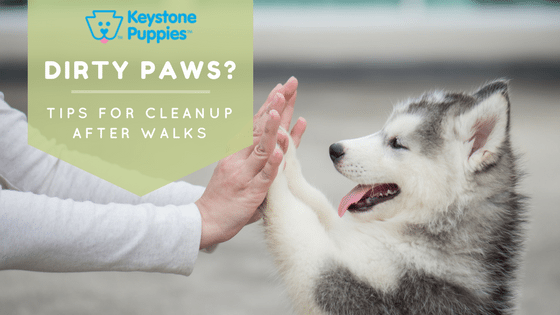
Everyone knows that April showers bring May flowers, but all that rain also means it’s easier than ever for your pup to get muddy on walks. Puppies and dogs naturally want to play in the dirt and mud, and a little play time during walks is healthy for your canine, even if it means they end up with mud on their coat. But some dog owners restrict walks and playtime because cleaning up their pup is difficult or unpleasant.
While baths are a great way to keep your pet looking and smelling clean, bathing too frequently can rob your dog’s coat of natural oils, and dry out his skin. Luckily, there are lots of ways to clean your pup’s paws after any walk, without visiting the tub. You don’t have to worry about your puppy getting a little dirty on Spring walks if you’ve planned ahead and set up a simple dog-cleaning station in advance.
Start by Teaching Your Pup Commands
Setting the stage for successful cleanups is important. It can be very stressful for you and your pet to wrestle around, trying to clean paws, or toweling off legs while your pet evades you. To keep cleanups as calm as possible, you must spend time training your dog to “stand” and “stay.” Get training tips from the American Kennel Club here. Teaching your puppy to hold these positions will make cleanups much faster and easier, and makes the process less confusing for your dog as well.
A Cleanup Station for Puppy Paws
Establishing a routine helps your dog understand expectations and reduces stress for you and your pet. Use the same door to leave and enter for each walk. It helps develop a routine, and it also allows you to find a permanent home for your cleanup station.
A cleanup station can be as simple as a bucket, some mild baby shampoo in a squeeze bottle, a washcloth, and an absorbent towel. Make sure the bucket’s top is low enough that your pup can easily dip his paw into it. Large breeds like Bernese Mountain Dogs and Weimaraners will need large buckets, but small breeds such as West Highland Terriers and Doxipoos may do better with a small plastic bowl. Use only mild shampoo. Baby shampoo is a gentle choice that also happens to be inexpensive.
If you suspect your pup may become muddy on your walk, fill the bucket or bowl with tepid (never hot) water before you start the walk. When you return, use the “stand” command, and dip your puppy’s paw into the water, using your hands to gently work out mud or dirt. Use a very small squirt of baby shampoo, if needed. If you use shampoo, make sure to rinse thoroughly. Shampoo residue can become itchy or irritate your pet’s skin.
Use the washcloth to wipe off any mud splatters on other parts of your pet. Dry the dog’s paws or other body parts with a towel. If your puppy is especially dirty, use the “stay” command, replace muddy water with clean water, and repeat the process as needed.
Don’t Rush Your Dog
Many dogs and puppies are fearful of this process in the beginning. It’s important to be patient with your puppy and spend more time on this process in the beginning to make it work smoothly in the long run.
Make sure you’re wearing casual clothes that can get dirty. The first few cleanups may include spills and could result in you or your pup getting extra wet. Don’t scold your pup for these mishaps. Instead, start over with a new bucket and proceed calmly. Staying even-tempered is an important part of making the cleanup process a positive experience for your dog.
If your dog or puppy is nervous, give him plenty time to test the water. Slow the process down and talk to your pup in a soothing voice. Let him get comfortable with the bucket, the towel, and the shampoo. It may help if you let your pup take time to smell everything. Giving him small treats during this acclimation period may also help him create positive associations with cleanup time.
What to do When There’s More Than Mud on Your Pup
Eventually, your puppy will come back from a walk with more than mud on his coat or in his paws. Spend extra time examining the paws and coats of breeds with long hair, like Chow Chows and Pomeranians.
If you find salt, mud, tree sap, burrs or even paint on your dog, gently apply vegetable oil or mineral oil to the area, and let it sit for 24 hours. You should then be able to wash it away with a little baby shampoo and water. If that doesn’t work, consider clipping the hair to remove the debris.
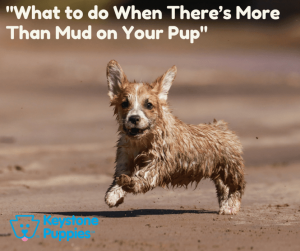
First Aid for Sore Paws
Sometimes you’ll notice your dog is stepping gingerly because something has lodged in his paws. After a walk in the snow, melting salt or ice balls can get stuck in your dog’s paw. Rinse their paws in a bucket of tepid water, and the gently probe his paws with your fingers to dislodge the object. Rinsing his paws will also remove salt chemicals.
If your dog gets cut, wounded, or experiences blood loss, treat the cut with an antibacterial wash and apply a light bandage. See a vet immediately if the cut is larger than half an inch in diameter or if the wound continues to bleed significantly after treatment.
How to Make Ongoing Dog Grooming Easier
While regular cleanups are essential to good dog grooming, there are also some preventative measures you can take to minimize grooming time after walks.
Spot Trims on Paws
Dog hair grows on their feet and between paw pads. For some pups, this long hair can become a magnet for dirt, debris, ice, or sand. Dirty paws are not only a household issue, but they can also increase the chances of infection for your canine pal. Dogs from snowy climates, like Alaskan Malamutes and Siberian Huskies often have this issue. Long paw hair is also common for Shih Tzus and Soft Coated Wheaten Terriers. Keep paw hair trimmed shorter to prevent matting and to make cleanups easier. As a rule, paw hair should not be longer than paw pads.
Spot Trims in Other Areas
Some dogs have long hair around tails, making elimination messy. Others have long coats on their legs or tails that get dirty during walks. If your pup’s coat is getting in the way of good grooming habits, consider trimming the hair in those areas.
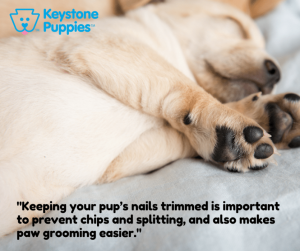
Well-Groomed Nails
If you can hear your dog’s nails click, they may be too long. Keeping your dog’s nails trimmed is important to prevent chips and splitting, and also makes paw grooming easier.
Products for Easier Dog Cleanups
While many dog owners will find the basic cleanup station works well, others may be interested in exploring some of the many products developed for helping you clean your pup between baths. Here are a few products worth exploring.
Dog Booties
Dog booties are a way to keep your pup’s paws warm while also keeping them cleaner. Booties may be a good solution for some dogs, but keep in mind that they can become slick in snow and rain, especially if your dog likes to run. Some dogs dislike the feel of the booties and may try to kick or chew them off.
Portable Dog Paw Cleaner
These cups are sized for small, medium, and large breed dogs. To use, add water and insert a paw into the mouth of the cup. The cup is filled with gentle bristles. Twist the cup to move the bristles over the puppy’s paws. Repeat as needed. This type of cleaner is helpful for cleaning paws on the go. You can purchase portable dog paw cleaners at most major pet supply stores or online.
Paw Wipes
Sometimes pre-moistened wipes are a great way to do quick cleanups. However, wipes formulated for people might be harmful to pups. If pre-moistened wipes interest you, look for pet formulations. Use hypoallergenic and fragrance-free formulas to minimize chances of reactions. Paw wipes are available at pet supply stores or online.
Dog Shammy
Absorbent towels are a must for canine cleanups. Dog shammies can replace towels and are usually able to absorb more water through the use of microfibers or special weaving techniques. Some offer hand pockets to make rubbing easier. Most shammies are machine washable, and usually retail for about $20 or less. Large pet supply stores and online stores offer a variety of options.
****
Pet Need Home Puppies cares about your pet’s well-being. Different breeds have different grooming needs. Not all products make sense for all dogs. Be sure to research the needs of your pup carefully. If you’re unsure about any aspect of cleaning or caring for your dog, ask your veterinarian for tips. If you haven’t decided which breed of dog is right for you, research over 200 breeds here. Want to search for your new puppy now? Click here to get started.




